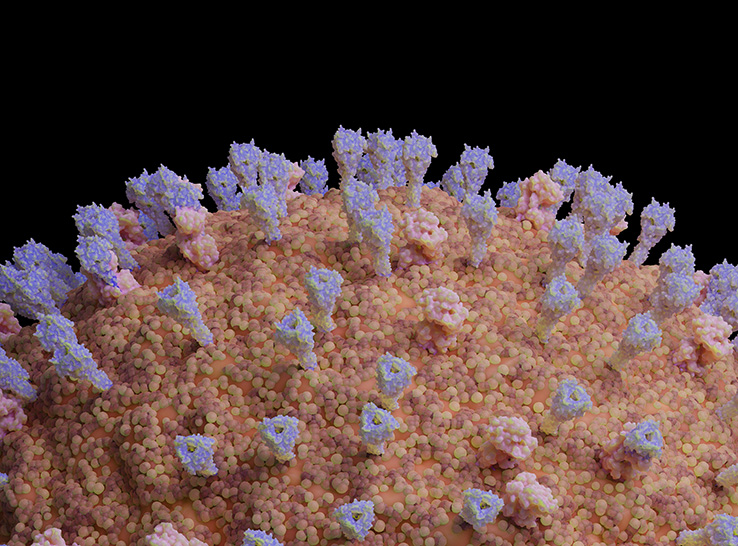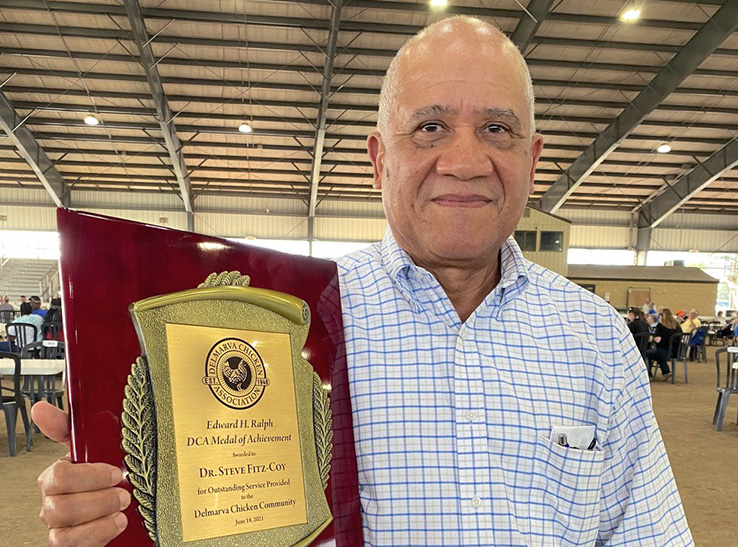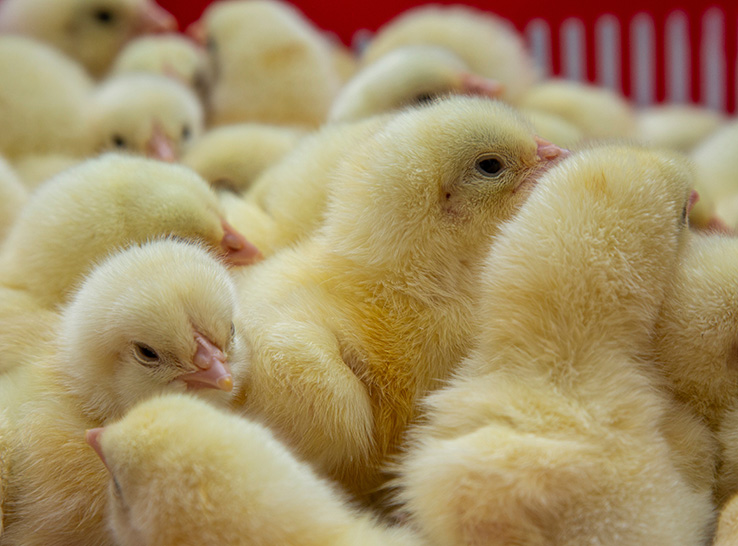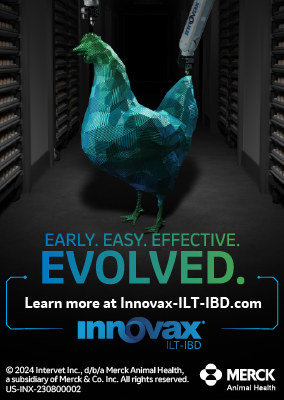 When poultry veterinarians asked Merck Animal Health to develop a recombinant vaccine that protected against infectious bursal disease (IBD) plus two other viral bugs – infectious laryngotracheitis (ILT) and Marek’s disease (MD) – scientist Stephanie Cook knew it would require more than adding an IBD antigen to an existing product line.
When poultry veterinarians asked Merck Animal Health to develop a recombinant vaccine that protected against infectious bursal disease (IBD) plus two other viral bugs – infectious laryngotracheitis (ILT) and Marek’s disease (MD) – scientist Stephanie Cook knew it would require more than adding an IBD antigen to an existing product line.
Nearly 20 years earlier, she and her research colleagues had already developed Innovax®-ILT, a recombinant vaccine that protected against ILT and MD. Years later, they developed Innovax®-ND-ILT, which also included protection against Newcastle disease.
Given the team’s track record, expanding the family of recombinant ILT vaccines to include IBD protection sounded simple on paper. But in the world of vaccine development, 1 + 1 doesn’t necessarily equal 2.
Building long-lasting vaccine
The challenge, Cook remembers thinking, was to develop the new ILT-IBD-MD recombinant vaccine without compromising the line’s two glycoproteins – a unique feature that scientists thought contributed to ILT protection that lasted 100 weeks, according to scientific data generated in Europe.1 Other ILT vaccines, whether live or recombinant, contain only one glycoprotein.
“In some of our early work, we looked at ILT genes individually and found two genes — glycoprotein D and glycoprotein I,” recalls Cook, a molecular biologist at Merck Animal Health who recently retired after 20 years with the company.
“They are right next to each other in the ILT virus. At the time, we had cloned a chunk of ILT with both glycoproteins attached for testing.”
Cook and her colleagues found the two genes together provided better protection than either of the genes by themselves. They used the herpes virus of turkeys (HVT) to host the insertion of the two-glycoprotein region of ILT, creating a HVT vaccine. That discovery led to the development of Innovax-ILT.
“We had the safety of the HVT backbone, which doesn’t cause disease in chickens, and it presented the ILT genes to the chicken’s immune system,” Cook explains. “When the chicken is exposed to ILT, the immune system wakes up and makes neutralizing antibodies against ILT.”
Two better than one
So, why are two glycoproteins better than one?
Glycoprotein D (gD) is required for the ILT virus to enter chicken cells. Once inside, it replicates and assembles new virus particles that can bud out of the cell and diffuse through the body to infect other cells. The second glycoprotein I (gI) forms a complex with glycoprotein E and can move the virus between cells.
“When administered to chickens together, the two glycoproteins present two different targets that the chicken can raise a defense against instead of one,” Cook says. “That has proved to be a distinctive advantage in protecting birds against the ILT virus.
“While the entire mechanism isn’t completely understood, I believe our vaccine provides robust protection by inducing an immune response against glycoproteins D and I of ILT,” she adds.
Stable construction
Another benefit of Innovax-ILT was its construction, which uses native ILT promoter and terminator sequences to lead to better expression.
A promoter is a sequence of DNA that is recognized by the RNA polymerase as a binding site to start making mRNA.
“The promoter strength functions like the accelerator in an automobile to determine how much antigenic protein will be made,” Cook explains.
But more is not always better. Too much antigen expression may result in a genetically unstable recombinant virus while insufficient antigen expression results in poor immune response.
“In both the native ILT virus and our Innovax-ILT vaccines, the mRNA transcript that is used to make gD protein extends through the gI gene. This configuration provides improved stability for the gD transcript,” Cook explains.
“And that may well be why gD is expressed well and is giving the bird what it needs in order to produce antibodies against ILT.”
Making combo vaccines
In the field, poultry veterinarians will sometimes mix compatible vaccines to protect against more diseases in one dose. Other times vaccines will be administered concurrently.
That’s not advisable with recombinant or other HVT vaccines, however. If producers administer two different HVT vaccines in the same flock –an HVT-ILT with an HVT-ND or HVT-IBD, for example – one or the other of the recombinant HVT viruses would outgrow and overtake the other, resulting in uneven flock protection. “One of the recombinant HVT viruses will get kicked out, and you never quite know which one it will be,” Cook says.
HVT vaccine combinations must therefore begin in the laboratory and pass safety and efficacy requirements of government regulators.
“Virus stability in a vaccine is very important because HVT continues to stimulate immunity for the life of the bird,” Cook says. “A recombinant HVT vaccine must be able to replicate well in the chick. The insertion of the antigens (foreign genes) also must remain stable in the genome of HVT while it remains in the bird to ensure a long duration of immunity.”
Knowing the importance of these two ILT glycoproteins to the integrity of Innovax-ILT, Merck Animal Health’s product-development team needed to proceed cautiously when creating its first sister product, Innovax-ND-ILT, and the latest addition to the family, Innovax®-ILT-IBD.
Researchers tested suitable locations in the HVT backbone for adding the other viral genes to build a vaccine.
To do this, scientists look for how the inserted genes affect the surrounding genes in the HVT backbone, and how they affect each other.
“Whenever new genes are added into the HVT genome, there is a risk of creating a virus that does not replicate well in the bird, or that may lose stability with replication,” Cook explains. “Decreased stability could result in reduced duration of immunity, so it’s important to get that right.”
When working on the new Innovax-ILT-IBD vaccine, Cook and her team tried various combinations in different locations within the virus until they found a configuration that was the best one for stability and antigen expression.
“We already knew that the combination of gD and gI provided really great ILT protection, so putting them together was definitely what we wanted to do,” she says. “We just needed to find the best way combine them with the IBD gene to provide a stable virus that expressed all three antigens well.”
Editor’s note: Content on Modern Poultry’s Industry Insights pages is provided and/or commissioned by our sponsors, who assume full responsibility for its accuracy and compliance.
1 European Commission, Annex 1, Summary of Product Characteristics. https://ec.europa.eu/health/documents/community-register/2023/20230414158750/anx_158750_en.pdf (Accessed Apr. 10, 2024).









